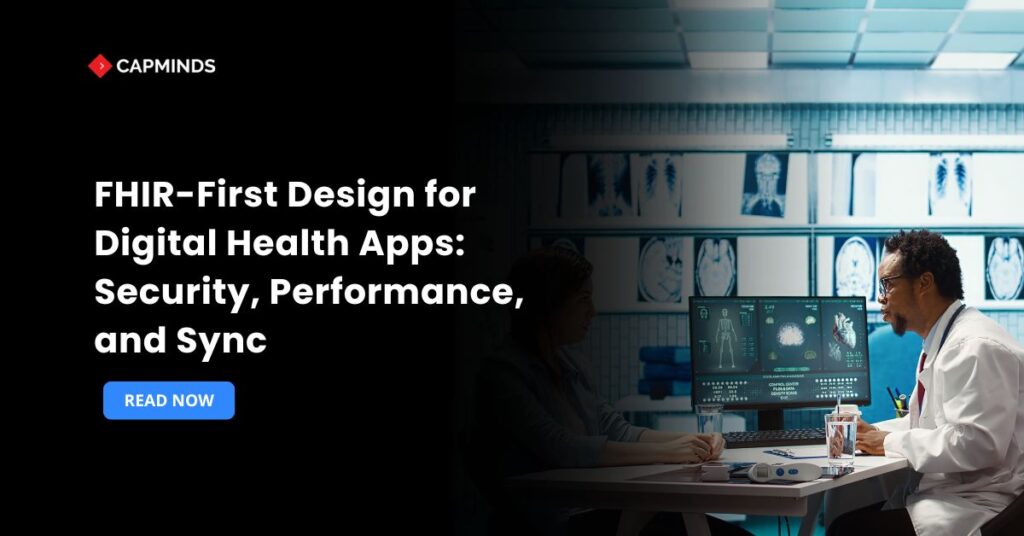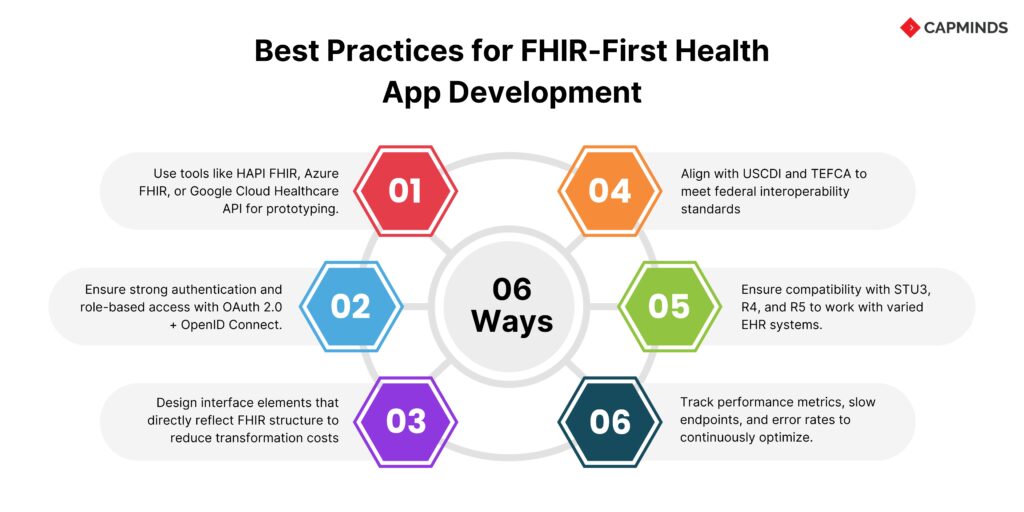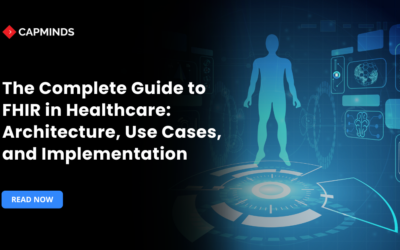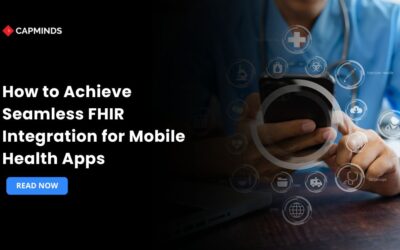FHIR-First Design for Digital Health Apps: Security, Performance, and Sync
Developers are under growing pressure to ensure their digital health apps are safe, scalable, and interoperable. Using HL7’s Fast Healthcare Interoperability Resources standard, they rapidly adapt to meet patient expectations and legal requirements.
In this blog, you’ll learn what an FHIR-first design strategy is, why it matters, and how it improves security, performance, and data synchronization across healthcare systems.
Whether you’re creating a telehealth app, a patient portal, or a mobile EHR interface, FHIR-first development establishes the groundwork for compliance, usability, and future-proof scalability.
What Is FHIR-First Design?
A FHIR-first design means that the app’s architecture is built on FHIR APIs and data models from the start, rather than adding FHIR support later. This method assures that your application communicates in the same “language” as most current healthcare systems and national health information exchanges.
Unlike traditional designs that rely on custom APIs or out-of-date standards, FHIR-first apps are designed from the ground up to enable structured, modular, and queryable health data, with RESTful APIs that function smoothly across cloud, mobile, and web platforms.
The key pillars of FHIR-first design are:
- FHIR resources such as patient, observation, and encounter are supported natively.
- Normal HTTP methods like GET, POST, PUT, and DELETE are used by REST API endpoints.
- Innovative architecture that complies with TEFCA and USCDI
- Data modeling is integration-ready from the start
Why is FHIR-First Important in Modern Healthcare Development?
The transition to value-based care and data-driven healthcare delivery has increased the demand for interoperability. The FHIR-first architecture ensures that your app may quickly integrate with EHRs, HIEs, payer systems, and third-party health platforms with minimal change.
Adopting an FHIR-first strategy from the start saves money on future revisions and ensures that your solution meets government regulations and payer criteria. It is also required for apps that participate in CMS programs, ONC certifications, or QHIN networks under TEFCA.
The advantages of FHIR-first preparedness include:
- Faster integration with EHR vendors such as Epic, Cerner.
- Simplified compliance with HL7, HIPAA, and USCDI
- Interoperability with National Data Exchange Frameworks
- Future-proof design prepared for AI and analytics.
Security Benefits of FHIR-First Applications
Security is the primary concern for any digital health system. Developers can use an FHIR-first approach to implement built-in safeguards that comply with industry-standard security protocols and healthcare-specific requirements.
The goal of FHIR APIs is to communicate with existing authentication systems like OpenID Connect, OAuth 2.0, and the SMART on FHIR protocol. Patients, providers, and administrators are just a few of the user groups that these systems enable with secure permissions.
The security advantages of FHIR-first architecture include:
- End-to-end encryption using HTTPS
- Role-based access restrictions for sensitive health data
- Scopes and permissions using SMART on FHIR
- Audit trails and tracking capabilities for compliance
Furthermore, a centralized FHIR server can serve as your application’s security perimeter, ensuring that all requests are validated, logged, and filtered before they reach sensitive backend systems. This reduces attack surfaces and enforces a zero-trust security approach.
Performance Improvements Through Modular Design
Digital health apps must provide quick and responsive user experiences while analyzing complicated clinical data. FHIR-first design promotes high performance by organizing data into modular, resource-based forms that may be searched or cached separately. FHIR resources are lightweight and granular compared to XML-based communications or monolithic data payloads.
This reduces latency and load times while allowing developers to access precisely the data they desire. FHIR-first architecture improves performance through
- Selective data retrieval with FHIR Search API
- Batch and transaction support for bulk processing
- Support for pagination and result filtering
- Easily cache commonly viewed resources
This efficiency is especially crucial for mobile health apps, which have limited bandwidth and device resources. A FHIR-first backend enables quick user interfaces while maintaining clinical depth and data integrity.
Sync Seamlessly Between Systems and Devices
Digital health requires real-time data synchronization, particularly when physicians and patients utilize the same app across several devices. Cross-platform synchronization is more scalable and reliable because of FHIR’s standardized structure.
Developers can use FHIR Subscription resources to transmit server updates to subscribing clients in near real time. This implies that test results, medication adjustments, and appointment updates may be mirrored across the app as soon as they are received in the backend system.
Key FHIR features that facilitate sync are:
- Subscribe for real-time push alerts.
- Provenance tracking to trace data origins and updates.
- Resource versioning for dispute resolution.
- Supports offline mode and local caching.
By integrating sync logic with FHIR’s event-driven features, apps may maintain consistent data states throughout user sessions, eliminating the need for manual refreshes and increasing user happiness.
Integration with EHRs and HIEs is made Easier
Most EHR manufacturers and HIEs now provide FHIR endpoints for data sharing, making FHIR-first apps simple to incorporate into current provider ecosystems. Instead of creating proprietary HL7 v2 or CDA adapters, your program may connect directly via FHIR interfaces.
This facilitates system mapping and drastically cuts down onboarding time. Information, including patient demographics, test results, imaging reports, and encounter data, may be accessed using standard FHIR queries.
The benefits of simpler EHR integration include:
- Shorter time-to-market for app deployments
- Improved data fidelity using structured formats
- Compatible with CMS-mandated APIs
- Reduced development and maintenance expenses.
Furthermore, many health organizations prioritize FHIR-compliant applications when evaluating collaborations, app store inclusion, or grant-funded experiments.
Best Practices for Developing an FHIR-First Digital Health Application
- Use Open Source FHIR Servers for Prototyping – To test queries and processes, use HAPI FHIR, Microsoft Azure FHIR Server, or the Google Cloud Healthcare API.
- Implement SMART on FHIR for Authentication – This provides a strong identity and access control layer designed specifically for healthcare.
- Design the User Interface – Map interface components directly to FHIR structures to ensure consistency and save transformation cost.
- Validate Against the US Core Profiles – Ensure that your app fulfills USCDI and TEFCA interoperability standards.
- Test on a variety of FHIR versions; depending on the partner system, support for STU3, R4, and R5 can be necessary.
- Track API Performance and Error Logs: Make use of analytics to improve response processing, identify slow endpoints, and optimize API usage.
Related: FHIR API Strategy for Health Systems: Build vs. Extend vs. Integrate
Empower Your Digital Health App with CapMinds’ FHIR-First Expertise
Building secure, high-performance, and interoperable digital health apps starts with the right foundation, and that foundation is FHIR.
At CapMinds, we specialize in helping healthcare innovators adopt a FHIR-first design that aligns with industry standards, ensures compliance, and supports seamless real-time data exchange.
With CapMinds, you get:
- End-to-end FHIR API development and integration
- SMART on FHIR implementation for secure user access
- EHR and HIE connectivity for provider and payer apps
- Scalable architecture optimized for performance and sync
- Compliance with USCDI, TEFCA, and HIPAA
Whether you’re launching a patient app, telehealth platform, or provider dashboard, CapMinds helps you build fast, stay compliant, and connect effortlessly.
Let’s turn your FHIR-first app vision into reality. Contact us today!





